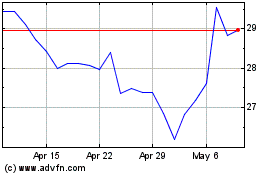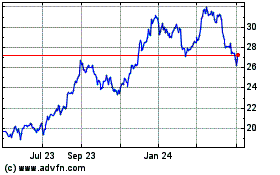The UBS Global Asset Management US Pension Fund Fitness Tracker
saw the funding ratio of the typical corporate US pension plan drop
by approximately one percentage point to 86% in the first quarter
of 2015.
"Funding ratios have continued to decline, decreasing on average
about nine percentage points since year- end 2013. Rates have
continued to decline, the yield on the long end of the Treasury
market has dropped a little over 20 basis points over the first
quarter. We reiterate our strongly held view that plans need to
adhere to their de-risking program as the timing/direction of
movements in long-term interest rates is uncertain," said Robert
Guzman, head of Pension Risk Management at UBS Global Asset
Management.
In the first quarter of 2015, liability values increased about
3.2%, mainly driven by the downward move in Treasury yields.
Investment returns were also positive, but at 1.9% could not fully
offset the increase in liabilities, resulting in approximately a
one percentage point decrease in funding ratios. These estimates
are based on the average corporate plan’s reported asset allocation
weightings from the UBS Global Asset Management Pension 500
Database and publicly available benchmark information.
In the Eurozone, the European Central Bank (ECB) began its
quantitative easing at a pace of EUR 60 billion of asset purchases
per month, while leaving its policy rate unchanged at 0.05%. The
start of the asset-buying program was followed by a weaker euro,
and even more negative sovereign yields. Earlier in January, the
Swiss National Bank surprised the market by removing the cap on the
value of its currency versus the euro, and by cutting its interest
rate further into negative territory to -0.75%. Negative sovereign
yields are no longer a rarity.
As the euro was selling off, the US dollar rose to its highest
level since 2003. As widely anticipated, the US Federal Reserve
(Fed) dropped the word "patient" from its most recent statement.
This seems to have been somewhat priced in already, and investors
shifted their attention to the pace of the rate hikes, which is
expected to be slower than initially anticipated.
The S&P 500 Index started the year with a negative return in
January, but went on to end the quarter up with a total return of
0.95%. In US dollar (USD) terms, the Euro Stoxx Total Return Index
was up 5.26% over the quarter. The MSCI Emerging Markets Total
Return Index ended the quarter 2.28% higher in USD terms.
The yield on 10-year US Treasury Notes ended the quarter down 25
basis points (bps) at 1.92%. The yield on 30-year US Treasury Notes
decreased 21 bps, ending at 2.54%. High-quality corporate bond
credit spreads, as measured by the Barclays Long Credit A+
option-adjusted spread, ended the quarter unchanged. As a result,
pension discount rates (which are based on the yield of
high-quality investment grade corporate bonds) decreased over the
quarter. The passage of time caused liabilities for a typical
pension plan to increase by about one percentage point over the
quarter. Together, these effects caused liabilities to increase
3.2% for the quarter. (Please see disclosures for assumptions and
methodology.)
Disclosures and methodology
Funding ratio
Funding ratios measure a pension fund’s ability to meet future
payout obligations to plan participants. The main factors impacting
the funding ratio of a typical US defined benefit plan are equity
market returns, which grow (or shrink) the asset pool from which
plan participants’ benefits are paid, and liability returns, which
move inversely to interest rates.
Liability indices: Methodology
Pension Protection Act (PPA) liability returns are approximated
by the Barclays Capital US Long Credit A-AAA Index. This index
broadly reflects the duration and credit characteristics of the PPA
discount curve that is used to discount expected pension benefit
payments for US defined benefit pension plans.
Asset index: Methodology
UBS Global Asset Management approximates the return for the
”typical” US defined benefit plan using the reported asset
allocation of the UBS Global Asset Management Pension 500 Database.
The series is constructed using the aggregate asset allocation
weightings and publicly available benchmark information, with
geometrically linked monthly total returns.
Pension Fund Fitness Tracker: Methodology
The US Pension Fund Fitness Tracker is the ratio of the asset
index over the liability index. Assuming all other factors remain
constant, it combines asset and liability returns and measures the
impact of a “typical” investment strategy on the funding ratio of a
model defined benefit plan in the US due to interest rollup, change
in interest rates and typical asset performance, but excludes
unique plan factors, such as service cost and benefit payments.
The UBS Global Asset Management Pension 500 Database
The UBS Global Asset Management Pension 500 Database is a
proprietary database that is based on the analysis of 500 public
companies sponsoring large defined benefit plans. The information
was extracted from the companies’ 10-K statements. The study may
include figures for companies’ nonqualified and foreign plans, both
of which are not subject to ERISA.
The aggregate asset allocation is based on an equally weighted
average of the 500 companies included in the database. The
aggregate asset allocation includes equities, fixed income, hedge
funds, private equity, real estate and cash.
Notes to Editors
About UBS Global Asset Management
Global Asset Management is a large-scale asset manager with
diversified businesses across investment capabilities, regions and
distribution channels. It offers investment capabilities and styles
across all major traditional and alternative asset classes
including equities, fixed income, currencies, hedge funds, real
estate, infrastructure and private equity that can also be combined
into multi-asset strategies. The fund services unit provides
professional services including fund set-up, accounting and
reporting for both traditional investment funds and alternative
funds.
About UBS
UBS draws on its over 150-year heritage to serve private,
institutional and corporate clients worldwide, as well as retail
clients in Switzerland. Its business strategy is centered on its
pre-eminent global wealth management businesses and its leading
universal bank in Switzerland, complemented by its Global Asset
Management business and its Investment Bank, with a focus on
capital efficiency and businesses that offer a superior structural
growth and profitability outlook.
UBS is present in all major financial centers worldwide. It has
offices in more than 50 countries, with about 35% of its employees
working in the Americas, 36% in Switzerland, 17% in the rest of
Europe, the Middle East and Africa and 12% in Asia Pacific. UBS
Group AG employs about 60,000 people around the world. Its shares
are listed on the SIX Swiss Exchange and the New York Stock
Exchange (NYSE).
Photos/Multimedia Gallery Available:
http://www.businesswire.com/multimedia/home/20150402006224/en/
Media InquiriesUBS Global Asset ManagementNew YorkGregg
Rosenberg, 212-713-8842Follow us on Twitter:
@UBSAmericasorwww.ubs.com/mediaFollow us on Twitter:
www.ubs.com/twitteramericas
UBS (NYSE:UBS)
Historical Stock Chart
From Mar 2024 to Apr 2024

UBS (NYSE:UBS)
Historical Stock Chart
From Apr 2023 to Apr 2024
